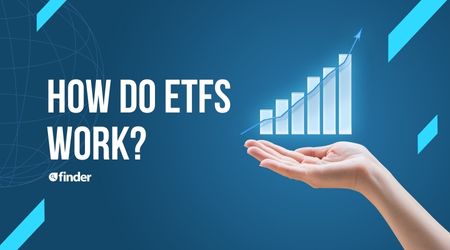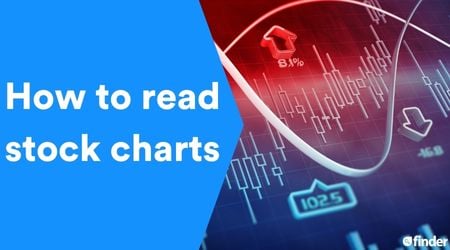If you’re a new investor, choosing individual stocks to invest in can be complicated and time-consuming. But ETFs and mutual funds offer a simple solution.
Both are types of investment funds hold a “basket” of stocks and bonds. They’re professionally managed, widely available, and they make it easy to diversify your investment portfolio.
But what are the similarities and differences between ETFs and mutual funds, and which type of fund is right for you? Let’s compare ETFs vs mutual funds to find out.
ETFs vs mutual funds: Side-by-side comparison
We’ll break down the similarities and differences between ETFs and mutual funds in detail further down the page. But if you want a quick summary of how they compare, check out the table below.
| Feature | ETFs | Mutual funds |
|---|---|---|
| Assets they hold | Stocks, bonds, cash, commodities and other securities | Stocks, bonds, cash, commodities and other securities |
| How they’re traded | Traded on exchanges just like stocks, so you can buy or sell ETF units throughout the trading day | Traded once a day at the end of each trading day |
| Active or passive management | Can be either | Can be either, but actively managed funds are more common |
| Fees |
|
|
| Minimum investment | The price of a single unit of the ETF. Or if you use a broker that supports fractional shares, you can invest with as little as $1 | Commonly $500 – $5,000, depending on the fund |
| Tax efficiency | More tax efficient | Less tax efficient |
What is an ETF?
ETF stands for exchange-traded fund. An ETF is an investment fund that pools together money from investors to buy a range of stocks or bonds.
ETFs are traded on a stock exchange just like shares in an individual company. But unlike stocks, when you buy a share in an ETF, you gain exposure to all the assets the fund holds.
ETFs are often passively managed index funds that aim to replicate the performance of an underlying index. For example, you could invest in a TSX 60 ETF to track the performance of 60 of the largest companies on the Toronto Stock Exchange, or gain exposure to 500 leading US companies with an S&P 500 ETF.
However, there are also actively managed ETFs that aim to outperform the market, and ETFs that focus on specific sectors such as tech, growth or dividend stocks.
What is a mutual fund?
Like an ETF, a mutual fund is a professionally managed investment fund that gathers together investor money. That money is then invested in a variety of assets, such as stocks and bonds.
As an investor, you can buy shares in a mutual fund to gain exposure to the assets it holds. Some mutual funds are actively managed to try to beat the market, but there are also index funds, fixed income funds, and funds that target specific market sectors.
But while you can buy ETFs on stock exchanges throughout the trading day, you can only buy mutual funds at the end of the trading day.
How are ETFs and mutual funds similar?
ETFs and mutual funds are similar because:
- Both are pooled investment funds. ETFs and mutual funds both pool together funds from investors to buy a basket of securities.
- Both can be passive or active. ETFs and mutual funds can either be passively or actively managed. Passively managed index funds aim to track the performance of a benchmark index, such as the S&P 500, while actively managed funds aim to outperform the market.
- Both provide access to a diversified basket of securities. ETFs and mutual funds make it easy to invest in a diversified portfolio of stocks simply by purchasing shares in the fund. This diversification means they generally come with a lower level of risk than investing in individual stocks.
- Both can be held in registered accounts. You can invest in both types of funds through registered accounts, such as an RRSP or TFSA, to take advantage of tax benefits. They can also be held in non-registered accounts.
According to the Investment Funds Institute of Canada, at the end of 2024:
- Mutual fund assets under management were at $2.242 trillion.
- ETF assets under management totalled $518 billion.
How are ETFs and mutual funds different?
How they’re traded
ETFs are bought and sold on stock exchanges just like stocks, at the current market price when you place your trade. It’s easy to buy and sell ETFs using an online brokerage account.
Meanwhile, mutual funds are priced at their Net Asset Value (NAV) and trades are executed once each day at the end of the trading day. You can buy mutual funds through an online brokerage or directly from the company that manages the fund.
Minimum investment amounts
If your broker supports fractional shares, you can invest in ETFs with as little as $1. If they don’t offer fractional shares, the minimum investment required is the cost of 1 unit in the ETF.
Mutual fund companies set minimum investment requirements for each fund. These commonly range anywhere between $500 and $5,000.
Fees
ETFs often have low or no buy fees, with some brokers offering $0 commission ETF trading. The other main cost you need to be aware of is the management expense ratio (MER). This is the fund’s management fee. It’s typically less than 0.25% for index funds, while actively managed funds often have MERs in the 0.5 – 1% range but can be higher. So if your ETF charges a fee of 0.1%, you’ll pay $1 in fees for every $1,000 you invest.
Some mutual funds charge commissions, known as load fees, which could be as much as 5%. However, no-load funds do not charge these fees.
You may also need to pay a trading commission to your online broker. For example, Questrade charges $9.95 per mutual fund trade, while CIBC Investor’s Edge charges $0 for money market mutual funds and $6.95 for all other mutual funds.
Finally, you’ll also need to take the fund’s MER into account. This could be less than 0.25% for an index fund, but actively managed funds could have MERs ranging from 0.5% to 3%.
Tax implications
ETFs are more tax efficient than mutual funds.
Due to their structure and the way they’re managed, ETFs don’t typically trigger capital gains events. Taxable events occur more frequently in mutual funds.
Mutual funds are also more likely to be actively managed than ETFs, meaning the asset manager often buys and sells stocks. This makes them less tax efficient.
Should I invest in ETFs or mutual funds?
ETFs and mutual funds are both worth considering if you want exposure to a diversified portfolio of assets. However, there are a few scenarios where one option or the other may be a better fit for you.
You might want to invest in ETFs if:
- You want low fees. ETFs, especially passively managed index funds, tend to have lower management fees than mutual funds.
- You only have a small amount to invest. While mutual funds often have minimum investment requirements ranging from $500 to $5,000, ETFs don’t. That means you can start investing with the cost of a single share of the ETF, or if your broker supports fractional shares, with as little as $1.
- You’re an active trader. Because they can be bought and sold on exchanges just like stocks, ETFs allow you to take advantage of price movements in real-time. You can also use advanced tools like limit orders and stop orders to get the price you want.
- You want to be tax efficient. Because of the way they’re traded, ETFs are usually more tax efficient than mutual funds.
You might want to invest in mutual funds if:
- You want to beat the market. Look for an actively managed fund if you want to try and outperform the market. Of course, it’s worth noting that there are also actively managed ETFs available.
- You want professional fund management. Mutual funds are managed by investment experts. Actively managed funds use a wide range of data, from quantitative analysis to fundamental and technical analysis about securities and economic trends. This information allows managers to buy and sell assets to capitalize on price fluctuations and try to beat the market.
- You don’t want to worry about timing your trade. Trying to time an ETF trade perfectly, with real-time prices fluctuating throughout the day, can be stressful and difficult. But if you invest in a mutual fund, they’re traded at the end of each day at a price based on their NAV.
How to choose the right ETF or mutual fund for you
No matter whether you’re investing in ETFs or mutual funds, here’s what you need to consider to find investments that meet your needs.
- Your investment goals. The first question you need to ask is why you’re investing. Are you building wealth for retirement, to buy a house, to pay for your children’s education, or some other target? What do you want to achieve with your investment, and in what time frame?
- Your risk tolerance. What is your appetite for risk? Do you want safe and steady returns or the potential for significant growth? Are you willing and able to ride out any short-term volatility for long-term returns?
- Fund goal. Read the fund’s prospectus to find out its investment objective. What is the goal of the fund and how does it aim to achieve that goal?
- Track record. Check performance figures and charts to see how the fund has performed over the past 1, 3, 5 and 10 years and whether it has met its objective. Of course, it’s worth remembering that past performance is no guarantee of future returns.
- Fees. Next, check the fund’s management expense ratio. Are there any other funds with similar holdings and objectives that charge lower fees?
- Minimum investment. Does the fund have a minimum investment requirement, and if so, is it affordable for you?
- Dividends. Finally, check whether the fund pays dividends to shareholders. How often are dividends paid and what is the dividend yield?
Compare Canadian brokerages to invest in ETFs or mutual funds
Finder Score for stock trading platforms
To make comparing even easier we came up with the Finder Score. Trading costs, account fees and features across 10+ stock trading platforms and apps are all weighted and scaled to produce a score out of 10. The higher the score, the better the platform—it's that simple.
Bottom line
ETFs and mutual funds both offer an easy way to invest in a diversified portfolio of assets. Both types of investment funds have their pros and cons, but both can form an important part of your investment strategy. Compare funds based on their goals, fees and holdings to make sure you choose ETFs or mutual funds that align with your investment goals.
Frequently asked questions
Sources
More guides on Finder
-
Private equity vs venture capital: A side-by-side comparison
Both involve private investment, but they differ in focus, strategy and the stage at which they invest in companies.
-
Best short-term investments in Canada
Where to invest your money in the short-term with low risk and high yield.
-
How to trade futures
Futures trading can be rewarding, but it’s not for everyone. Learn the steps to trade futures, including examples and fees to consider.
-
Investment calculator
Use this calculator to find out how much you can grow your money.
-
Investing in your 30s: 8 wealth-building tips
Prepare to revamp your asset allocation and explore new investment classes when you’re in your 30s.
-
How to start investing in your 20s: The 7 tips for beginners
Read our 7 tips for starting a portfolio if you’re new to investing.
-
Real estate investment
Check out these real estate investment options from REITs and rentals to mutual funds, house flipping and more.
-
Questwealth Portfolios vs Wealthsimple: Which robo-advisor is right for you?
Find out which of these popular Canadian robo-advisors you should choose to for your financial situation.
-
What are bonds? A full guide for Canadians
Bonds are fixed-income assets that earn interest. But bonds may underperform other asset classes in the long run.






